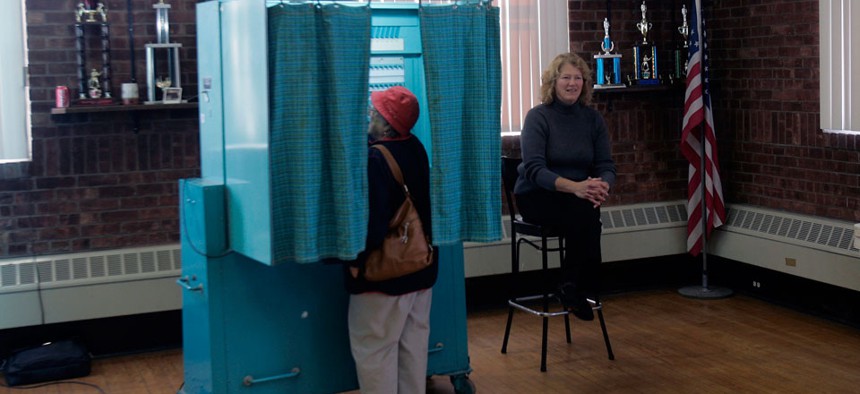Anti-Incumbent Fever Won't Oust Many Incumbents
Don't expect many members of Congress to lose their seats next year, despite Congress's 9 percent approval rating.
If you think about it, all the ingredients necessary for a political explosion are in place: Congress's unfavorable ratings are at record-high levels, and, according to Gallup, its favorable ratings are down to 9 percent (who knew members had so many friends and family?). A large segment of the electorate is furious with Republicans over the shutdown, and a second group is boiling over about Obamacare (or as the White House once again calls it, the Affordable Care Act), with some of that group angry at the substance of the law and some at the launch debacle. Gallup's weekly presidential job-approval ratings for Nov. 11-17 had President Obama's approval at just 41 percent. And to add a cherry on top, an obscure House member (Florida Republican Trey Radel) has pleaded guilty to cocaine possession. You would think that all of this would add up to a highly combustible political situation.
The big problem with this notion is that, for a variety of reasons, the bomb is unlikely to explode. Few members of Congress will face any remotely credible opposition next year, in either the primary or the general election. This has a lot to do with the number of congressional districts where one party is overwhelmingly dominant, stemming from redistricting, population sorting, and Democratic voters concentrating in urban areas and college towns while Republicans tend to evenly spread elsewhere. The Cook Political Report's House editor and chief number cruncher, David Wasserman, reports that Obama carried only 690 counties last year (fewer than Michael Dukakis's 818 in 1988), compared with Mitt Romney's total of 2,424. That is how concentrated the Democratic vote is in population centers. Between congressional retirements and wave elections, very few Democrats now represent districts that God didn't intend for a Democrat to hold, and few GOP members hold seats not intended for a Republican. The Senate isn't quite as bad as the House in this regard, but there are plenty of one-party states, as well.
Putting some of the more titillating aspects of the race aside, Liz Cheney's Republican primary challenge to Sen. Michael Enzi in Wyoming is notable because few incumbents in safe seats ever actually face such challenges, even in times when Washington and Congress are held in, as they say, minimally high regard by the public.
The numbers on incumbent reelection rates are pretty remarkable. I highly recommend that political aficionados spend some time thumbing through the 2013 edition of Vital Statistics on Congress, by Norman J. Ornstein, Thomas E. Mann, Michael J. Malbin, and Andrew Rugg (now available for free in PDF form at the Brookings Institution's website). Only once since the end of World War II has the percentage of House members successfully seeking reelection dropped below 80 percent; that was when it dipped to 79.3 percent in 1948. In the more volatile Senate, in six of the seven elections between 1946 and 1958, the percentage of senators who sought reelection and won was below 80 percent. From the 1960s onward, the Senate's reelection rate has usually been in the 70s and 80s, occasionally the 90s. But it did drop to the low-to-mid-60s in the 1976 and 1978 elections and then to 55.2 percent in 1980, a three-election sequence that stands out in volatility.
Only three times since 1980 and eight times since 1946 have 10 or more House members lost renomination; five of those eight times—including 2012, when 13 members lost their primaries, and 1992, when 19 did—were in the first elections after redistricting, when incumbents are sometimes forced to run against each other. Only in four elections since 1946 has the number of senators losing primaries numbered four or more; the last time was in 1980.
In so many cases, primary- or general-election challengers are just names on a ballot—warm bodies and not much else. These opponents to well-established incumbents have little if any money, name recognition, or campaign infrastructure; they will simply be names in the Almanac of American Politics for having run.
The reality is that for most members of Congress—certainly for senators—the fear of losing is vastly overblown. Few realistically could lose their seats (and those who could likely already know who they are). In some cases, members don't so much fear losing; they fear having a nasty and highly inconvenient campaign. When the reelection rate in the House drops, for example, it's usually only one party that sees a decrease. The other party usually enjoys an increase in those years, like a child's seesaw. If one side goes down, the other side goes up, so it isn't a "throw the bums out" election, it's either "throw the Democratic bums out" or "throw the Republican bums out." The notable exceptions to this rule occurred after the House bank and post-office scandals of the early 1990s.
Wave elections are very real, but they are very party-specific. A large partisan wave is highly unlikely in 2014, because voters hate Democrats in Congress while simultaneously despising Republicans. To vote against one party, people have to vote for another in very large numbers, which at this point seems unlikely. The government shutdown and related antics on the GOP side are offset by the disastrous launch of the Obamacare website and underlying public skepticism about the law. So, take all of the numbers we're seeing with a grain of salt; they aren't likely to amount to much more than that.



